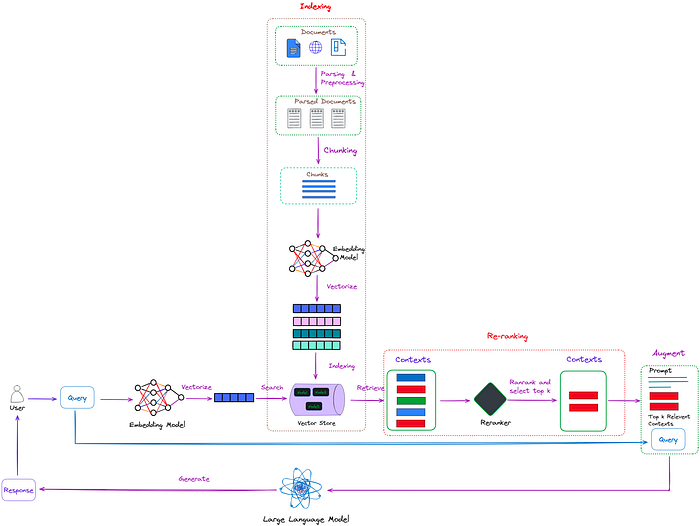
Advanced RAG 04: Re-ranking
Author(s): Florian June
Originally published on Towards AI.
From Principles to Two Mainstream Implementation Methods
Re-ranking plays a crucial role in the Retrieval Augmented Generation (RAG) process. In a naive RAG approach, a large number of contexts may be retrieved, but not all of them are necessarily relevant to the question. Re-ranking allows for the reordering and filtering of documents, placing the relevant ones at the forefront, thereby enhancing the effectiveness of RAG.
This article introduces RAG’s re-ranking technique and demonstrates how to incorporate re-ranking functionality using two methods.
Figure 1: Re-ranking in RAG, the task of re-ranking is to evaluate the relevance of these contexts and prioritize the ones(red boxes) that are most likely to provide accurate and relevant answers. Image by author.
As shown in Figure 1, the task of re-ranking is like an intelligent filter. When the retriever retrieves multiple contexts from the indexed collection, these contexts may have different relevance to the user’s query. Some contexts may be very relevant (highlighted in red boxes in Figure 1), while others may only be slightly related or even unrelated (highlighted in green and blue boxes in Figure 1).
The task of re-ranking is to evaluate the relevance of these contexts and prioritize the ones that are most likely to provide accurate and relevant answers. This allows the… Read the full blog for free on Medium.
Join thousands of data leaders on the AI newsletter. Join over 80,000 subscribers and keep up to date with the latest developments in AI. From research to projects and ideas. If you are building an AI startup, an AI-related product, or a service, we invite you to consider becoming a sponsor.
Published via Towards AI
Take our 90+ lesson From Beginner to Advanced LLM Developer Certification: From choosing a project to deploying a working product this is the most comprehensive and practical LLM course out there!
Towards AI has published Building LLMs for Production—our 470+ page guide to mastering LLMs with practical projects and expert insights!

Discover Your Dream AI Career at Towards AI Jobs
Towards AI has built a jobs board tailored specifically to Machine Learning and Data Science Jobs and Skills. Our software searches for live AI jobs each hour, labels and categorises them and makes them easily searchable. Explore over 40,000 live jobs today with Towards AI Jobs!
Note: Content contains the views of the contributing authors and not Towards AI.














